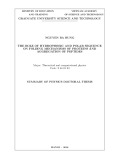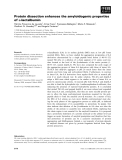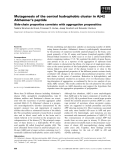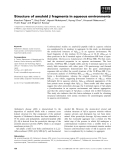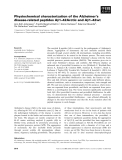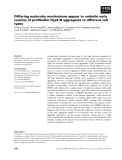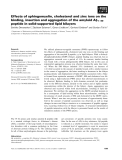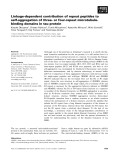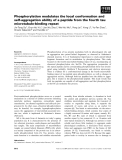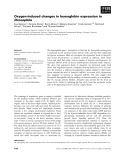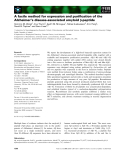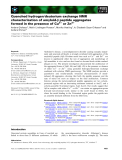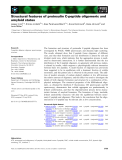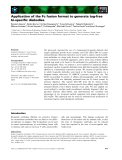
Aggregation of peptides
-
The objectives of the thesis: The aim of the studies is to gain fundamental understanding of the role of hydrophobic and polar sequence on folding mechanism of proteins and aggregation of peptides
 33p
33p  xacxuoc4321
xacxuoc4321
 09-07-2019
09-07-2019
 44
44
 4
4
 Download
Download
-
a-lactalbumin (LA) in its molten globule (MG) state at low pH forms amyloid fibrils. Here, we have studied the aggregation propensities of LA derivatives characterized by a single peptide bond fission (1–40⁄41–123, named Th1-LA) or a deletion of a chain segment of 12 amino acid resi-dues located at the level of the b-subdomain of the native protein (1– 40⁄53–123, named desb-LA). We have also compared the early stages of the aggregation process of these LA derivatives with those of intact LA....
 13p
13p  awards
awards
 06-04-2013
06-04-2013
 44
44
 2
2
 Download
Download
-
Protein misfolding and deposition underlie an increasing number of debili-tating human disorders. Alzheimer’s disease is pathologically characterized by the presence of numerous insoluble amyloid plaques in the brain, com-posed primarily of the 42 amino acid humanb-amyloid peptide (Ab42). Disease-linked mutations in Ab42 occur in or near a central hydrophobic cluster comprising residues 17–21.
 11p
11p  dell39
dell39
 27-03-2013
27-03-2013
 45
45
 5
5
 Download
Download
-
Conformational studies on amyloidb peptide (Ab) in aqueous solution are complicated by its tendency to aggregate. In this study, we determined the atomic-level structure of Ab28)42 in an aqueous environment. We fused fragments of Ab, residues 10–24 (Ab10)24) or 28–42 (Ab28)42), to three positions in the C-terminal region of ribonuclease HII from a hyper-thermophile, Thermococcus kodakaraensis(Tk-RNase HII).
 9p
9p  dell39
dell39
 27-03-2013
27-03-2013
 42
42
 3
3
 Download
Download
-
The amyloidbpeptide (Ab) is crucial for the pathogenesis of Alzheimer’s disease. Aggregation of monomeric Ab into insoluble amyloid fibrils proceeds through several soluble Abintermediates, including protofibrils, which are believed to be central in the disease process. The main reason for this is their implication in familial Alzheimer’s disease with the Arctic amyloid precursor protein mutation (E693G).
 13p
13p  inspiron33
inspiron33
 26-03-2013
26-03-2013
 51
51
 4
4
 Download
Download
-
Considerable attention has been paid to the high cytotoxic potential of small, prefibrillar aggregates of proteins⁄peptides, either associated or not associated with amyloid diseases. Recently, we reported that different cell types are variously affected by early aggregates of the N-terminal domain of the prokaryotic hydrogenase maturation factor HypF (HypF-N), a pro-tein not involved in any disease.
 17p
17p  inspiron33
inspiron33
 26-03-2013
26-03-2013
 42
42
 4
4
 Download
Download
-
We utilized plasmon-waveguide resonance (PWR) spectroscopy to follow the effects of sphingomyelin, cholesterol and zinc ions on the binding and aggregation of the amyloidbpeptide1)40 in lipid bilayers. With a dioleoyl-phosphatidylcholine (DOPC) bilayer, peptide binding was observed, but no aggregation occurred over a period of 15 h.
 14p
14p  inspiron33
inspiron33
 26-03-2013
26-03-2013
 45
45
 5
5
 Download
Download
-
Although one of the priorities in Alzheimer’s research is to clarify the fila-ment formation mechanism for the tau protein, it is still unclear how it is transformed from a normal structure in a neuron. To examine the linkage-dependent contribution of each repeat peptide (R1–R4) to filament forma-
 11p
11p  media19
media19
 06-03-2013
06-03-2013
 34
34
 2
2
 Download
Download
-
Phosphorylation of tau protein modulates both its physiological role and its aggregation into paired helical fragments, as observed in Alzheimer’s diseased neurons. It is of fundamental importance to study paired helical fragment formation and its modulation by phosphorylation. This study focused on the fourth microtubule-binding repeat of tau, encompassing an abnormal phosphorylation site, Ser356.
 9p
9p  media19
media19
 04-03-2013
04-03-2013
 30
30
 1
1
 Download
Download
-
The amyloidbpeptide (Ab) with 39–42 residues is the major component of amyloid plaques found in brains of Alzheimer’s disease patients, and solu-ble oligomeric peptide aggregates mediate toxic effects on neurons. The Ab aggregation involves a conformational change of the peptide structure to b-sheet.
 9p
9p  vinaphone15
vinaphone15
 28-02-2013
28-02-2013
 47
47
 3
3
 Download
Download
-
A facile method for expression and purification of the Alzheimer’s disease-associated amyloid b-peptide ´ Dominic M. Walsh1, Eva Thulin2, Aedın M. Minogue1, Niklas Gustavsson3, Eric Pang4, David B.
 16p
16p  vinaphone15
vinaphone15
 27-02-2013
27-02-2013
 56
56
 3
3
 Download
Download
-
Alzheimer’s disease, a neurodegenerative disorder causing synaptic impair-ment and neuronal cell death, is strongly correlated with aggregation of the amyloid-bpeptide (Ab). Divalent metal ions such as Cu 2+ and Zn 2+ are known to significantly affect the rate of aggregation and morphology of Abassembliesin vitro and are also found at elevated levels within cerebral plaquesin vivo.
 10p
10p  vinaphone15
vinaphone15
 25-02-2013
25-02-2013
 47
47
 4
4
 Download
Download
-
The formation and structure of proinsulin C-peptide oligomers has been investigated by PAGE, NMR spectroscopy and dynamic light scattering. The results obtained show that C-peptide forms oligomers of different sizes, and that their formation and size distribution is altered by salt and divalent metal ions, which indicates that the aggregation process is medi-ated by electrostatic interactions.
 10p
10p  viettel02
viettel02
 19-02-2013
19-02-2013
 44
44
 3
3
 Download
Download
-
Alzheimer’s disease (AD) is an age-related, progressive degenerative dis-order that is characterized by synapse and neuron loss in the brain and the accumulation of protein-containing deposits (referred to as ‘senile plaques’) and neurofibrillary tangles. Insoluble amyloid b-peptide (Ab) fibrillar aggregates found in extracellular plaques have long been thought to cause the neurodegenerative cascades of AD.
 11p
11p  mobifone23
mobifone23
 18-01-2013
18-01-2013
 51
51
 4
4
 Download
Download
-
We previously reported the use of a humanized bi-specific diabody that targets epidermal growth factor receptor and CD3 (hEx3-Db) for cancer immunotherapy. Bacterial expression can be used to express small recombi-nant antibodies on a large scale; however, their overexpression often results in the formation of insoluble aggregates, and in most cases artificial affinity peptide tags need to be fused to the antibodies for purification by affinity chromatography.
 11p
11p  mobifone23
mobifone23
 18-01-2013
18-01-2013
 48
48
 3
3
 Download
Download








